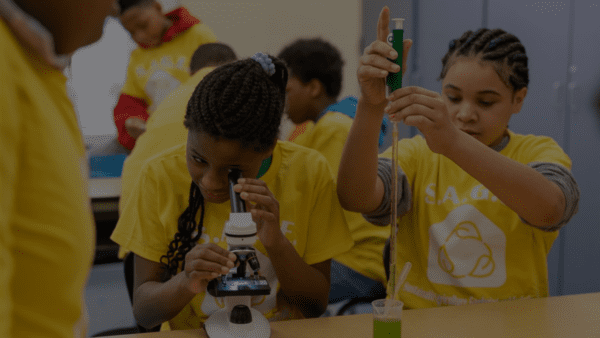Why STEM Matters (And How to Make It Work for You)
We know you’re doing the best you can. Parenting is hard, and finding extra time for anything can feel impossible. With everyone talking about STEM or STEAM learning, it can seem like just another task on your already overflowing to-do list. If you’re a parent of a middle schooler, it might feel like you’re supposed to have it all figured out by now. But let’s be real: it’s okay if you don’t.
The good news is that you don’t need much time or money to support your child’s interest in science, technology, engineering, and math. There are simple, affordable ways to make STEM a natural part of your everyday life, and they don’t all involve making slime.
Too busy to read this now? No worries. Bookmark it for later—this resource is here to help, so do not add more stress. These practical tips and resources are here for you and are perfect for those moments when your kiddo says, “I’m bored.”
Free and Low-Cost STEM Resources
The internet is a treasure trove of free STEM resources. Websites like Khan Academy, Coursera, and edX offer high-quality courses at no cost.
But, for something a bit more off the beaten path, check out CK-12 for customizable STEM lessons or OpenLearn from the Open University for various STEM subjects.
Educational websites like NASA for Kids and Code.org provide engaging content that can turn screen time into learning time.
Want more online options?
For more STEM learning resources, explore the Top 72 Free STEM Websites for Middle School Students.
Additionally, your local library is a goldmine of free resources. Many libraries offer free access to books, educational kits, and even STEM-related programs. For example, you might find The Boy Who Harnessed the Wind by William Kamkwamba, a great book about innovation and resourcefulness, or Rosie Revere, Engineer by Andrea Beaty, which inspires young inventors. Libraries often host STEM workshops and reading clubs that make learning interactive and fun. Check your library’s website or visit in person to discover programs like Maker Mondays or Science Saturdays.
Public schools often offer after-school STEM programs and clubs. Start by asking your child’s teachers about available programs. Check your school’s website or district’s community education office for information. Local community centers and nearby universities might also offer programs for middle school students. Websites like After School Alliance and STEMfinity can help you find programs in your area.

Creative STEM Projects and Everyday Learning Opportunities
Exploring STEM at home doesn’t require fancy equipment. Simple science experiments and engineering projects can be done with everyday items. For example, you can create a homemade volcano using baking soda and vinegar or explore basic circuitry with a battery, aluminum foil, and a small light bulb. Gardening is another excellent way to teach ecology and biology. For one fun idea, check out the STEM Greenhouse’s page for a fun experiment and YouTube tutorial on Volume, Mass, Density, and Cartesian Divers.
More Example DIY Projects:
- Homemade Volcano: It’s tradition 🙂
- Basic Circuit: Build your own with a battery, foil, and a lightbulb!
- Gardening: Explore biology by planting seeds and observing their growth.
STEM is integrated into our daily lives, often in ways we may not immediately recognize. For example, cooking can teach chemistry through mixing ingredients and observing chemical reactions, while building structures with household items like straws and clay can introduce engineering concepts. Grocery shopping can turn into a math lesson by calculating discounts and percentages. Nature walks can turn into biology field trips, and fixing a bike can teach physics and engineering principles. Encourage problem-solving and critical thinking with puzzle challenges and coding games.
Fostering a growth mindset and encouraging questions are crucial for STEM learning. Celebrate successes and treat failures as learning opportunities to build resilience and a love for learning. Welcome curiosity and exploration through encouragement, even if you don’t know the answers–great bonding opportunities can occur as you research them together!

Community Support for STEM Learning
As STEM is a hot topic, local and community organizations have many opportunities. It’s just about finding the right fit for your family. Participating in local science fairs and STEM events can be incredibly rewarding. If your school doesn’t have a science fair, consider organizing a small neighborhood fair or look for community-sponsored events at local museums or science centers. These events provide a platform to showcase projects and allow kids to network and learn from peers.
Nonprofits like STEM Greenhouse offer programs designed to make STEM accessible to all. Organizations like Black Girls CODE, Boys & Girls Clubs of America, and 4-Halso have excellent STEM initiatives. Still worried about the cost of participating? Often, grants and scholarships are available to qualifying families to help financially support participation. Sometimes, these resources are hidden, so it may take a phone call or email to ask.
Media Resources for Continued STEM Learning
Rainy day? No energy to make a mess or go anywhere? That’s okay! There are many opportunities to explore STEM from the comfort of your couch.
Engaging articles, magazines, and movies can inspire and educate your middle schooler without ever leaving home.
Free STEM Articles to Read for Middle School-Aged Students
- Why Is Wombat Poop Cube-shaped? – by Tik Root, National Geographic
- The Mind Behind the Web, by Mark Fischetti, Scientific American
- How Much Does the Milky Way Weigh?, by Michelle Z. Donahue, National Geographic
- What Is Climate Change?, by NASA Climate Kids
- What Is Wind Chill, and How Does It Affect Your Body?, by Sarah Gibbens, National Geographic
- What Is the Jet Stream—and How Does it Influence the Weather? – by Christina Nunez, National Geographic
- Phases of the Moon, Explained, by Victoria Jaggard, National Geographic
Free STEM Journals and Magazines for Middle School Students
- Young Scientist Journal
- Science Journal for Kids
- NSTA’s Science Scope
- International Journal of Youth-Led Research
- Science News Explores
WATCH (with Free and/or Subscription Streaming Suggestions)
- Behind the Scenes: How Things Work – National Geographic Kids YouTube, New episodes, Mondays at 3 pm ET
- Description: Explore the science and engineering behind everyday objects and phenomena.
- Rating: G
- Hidden Figures – Available for free on ABC’s website during certain times.
- Description: The true story of three African-American women mathematicians who played crucial roles at NASA during the early years of the U.S. space program.
- Rating: PG
- Dream Big: Engineering Our World – streaming on Roku
- Description: A documentary that celebrates the human ingenuity behind engineering marvels and the lives of engineers who make these wonders a reality.
- Rating: G
- Bill Nye: Science Guy (Series) – free on archives.org
- Bill Nye explores scientific concepts and their impact on our daily lives.
- Rating: TV-G
The following may require a purchase or subscription
- October Sky
- Description: Based on a true story, this film follows a group of boys inspired by the launch of Sputnik who strive to build their own rocket.
- Rating: PG
- Apollo 13
- Description: The dramatic retelling of the Apollo 13 mission showcases teamwork, problem-solving, and engineering under pressure.
- Rating: PG (critics say it’s closer to PG-13)
- A Beautiful Mind
- Description: The story of John Nash, a brilliant mathematician who contributed significantly to game theory, all while battling personal challenges.
- Rating: PG-13
- The Imitation Game
- Description: The story of Alan Turing, who cracked the Enigma code during World War II, highlighting the importance of cryptography and computer science.
- Rating: PG-13
- Our Planet
- Description: A documentary series that showcases the planet’s natural beauty and examines how climate change impacts all living creatures.
- Rating: TV-G
Disclaimer: This post contains affiliate links. If you click through and make a purchase, STEM Greenhouse may receive a small commission at no additional cost to you. This helps support our mission. Additionally, the information and recommendations provided in this post are based on personal experience and research. Always use your best judgment and consider the safety and suitability of projects, articles, shows, movies, and other resources for your child. Parental supervision is advised for all activities and media consumption.






